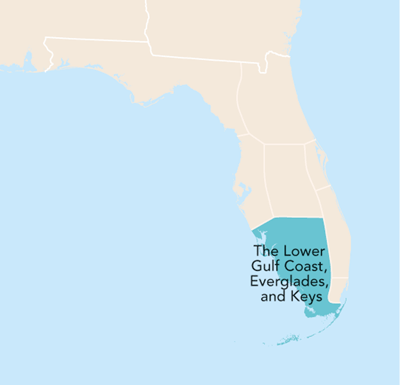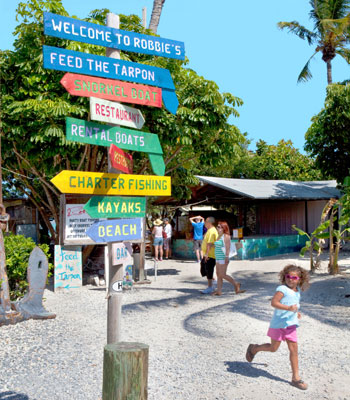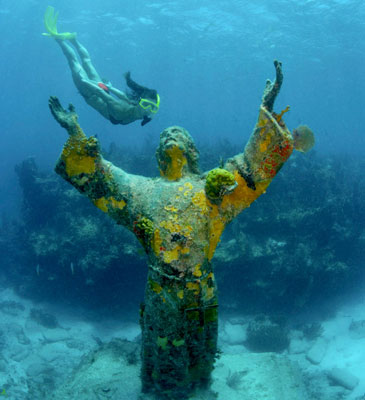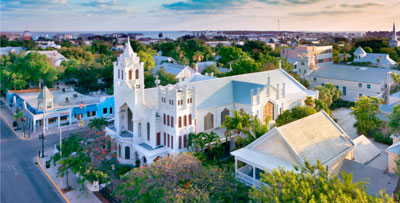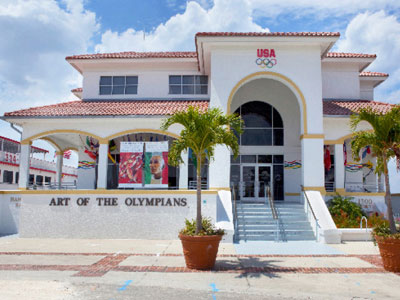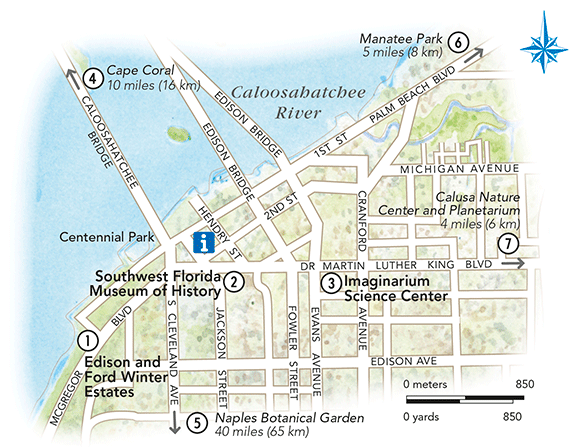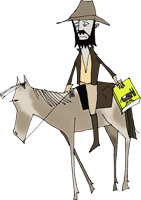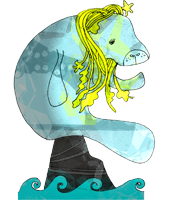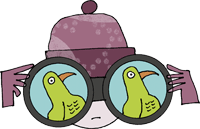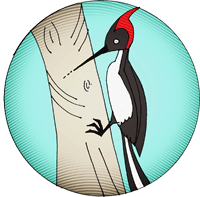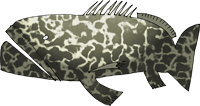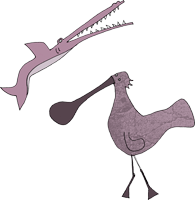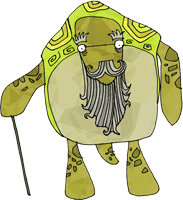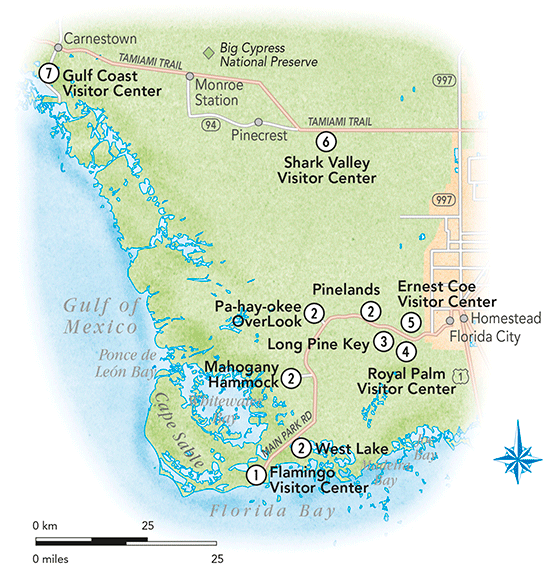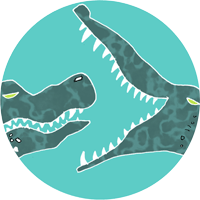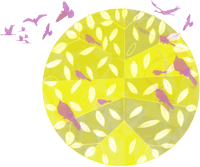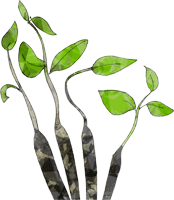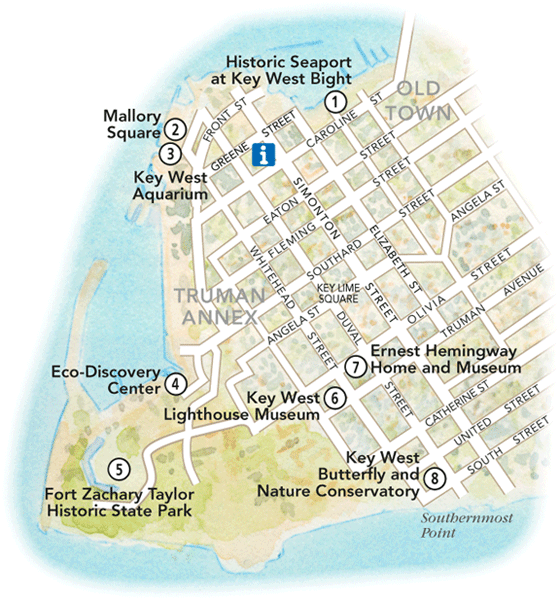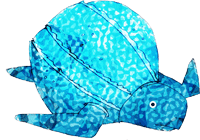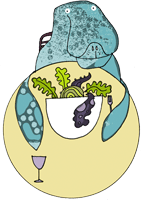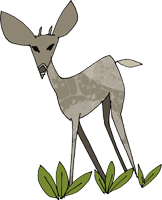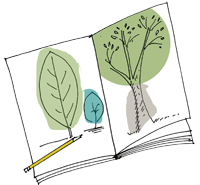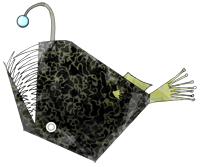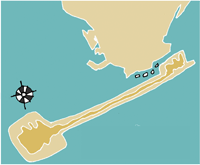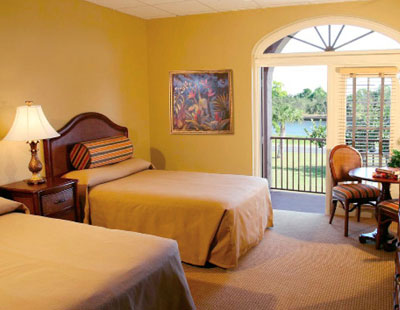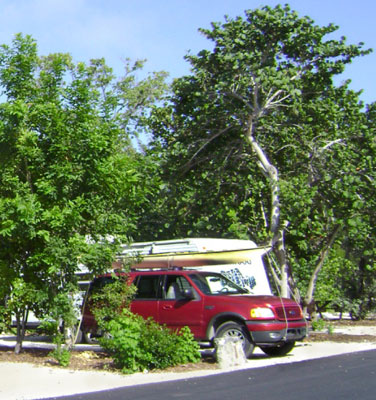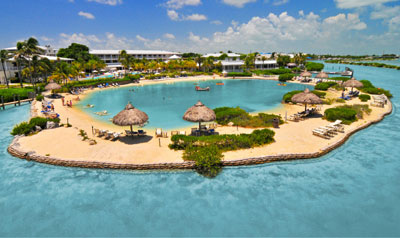< The Lower Gulf Coast,
Everglades, and Keys
The Lower Gulf Coast, Everglades, and Keys
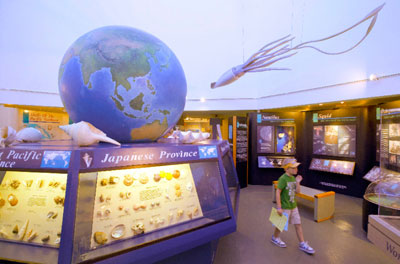
Informative displays in the Bailey-Matthews Shell
Museum, Sanibel Island
Florida tapers off to its narrowest and flattest at
its southern tip. While barrier islands rim the shoreline along the Gulf
Coast, sandy beaches, mangrove estuaries, saltwater marshes, and the
shallow Florida Bay make up the unique Everglades. Farther south are the
Florida Keys, a string of islands that rest on a bed of coral and
limestone from ancient reefs. The Tamiami Trail (Highway 41), known as
“Alligator Alley” when it passes through the Everglades, connects the
areas in this region. Interstate 75 is a faster route, which links Fort
Lauderdale to Fort Myers and Naples.
1. Fort Myers
2. Sanibel and
Captiva Islands
3. Upper Islands
4. J. N. “Ding”
Darling National Wildlife Refuge
5. Corkscrew
Swamp Sanctuary
6. Naples
7. Marco Island
8. Everglades
National Park
9. Biscayne National
Park
10. Miccosukee
Indian Village
11. Big Cypress
National Preserve
12. Everglades
City
13. Key West
14. Big Pine Key
15. Bahia Honda
State Park
16. Marathon
17. Islamorada
18. Key Largo
19. John Pennekamp
Coral Reef State Park
< The Lower Gulf Coast,
Everglades, and Keys
1. Fort Myers
Sunny skies and island beaches
Kids’ Corner
Do you know…
Unlike cattle drivers in the
West, those in Florida took offense at being
called “cowboys.” Do you know what they were
called instead?
Fort Myers’ Summerlin Avenue
is named for Jake Summerlin. Who was he?
Is it true that manatees feed
on fish?
Inventions Galore
Thomas Edison patented more than 1,000
inventions in his lifetime. The museum at the Edison and
Ford Winter Estates displays many of them. Edison also
helped to put an end to the practice of free-ranging, as he
got tired of cattle roaming through his gardens.
Garden riddles
Look for the answers to these tree riddles
in the Edison and Ford Winter Estates:
I’d like this with
shortcake.
I’ll take this to the
movies.
I’ll order this with eggs
for breakfast.
We should crown this tree
king or queen.
< The Lower Gulf Coast,
Everglades, and Keys
2. Sanibel and Captiva Islands
Shell-bent and water-bound
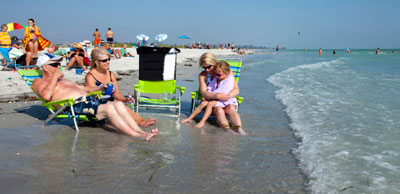
Vacationers at one of Sanibel Island’s beautiful
beaches
These two barrier islands, attached by a short bridge,
boast a reputation for shelling, and also for wildlife and watersports.
The islands have given rise to the expressions Sanibel Stoop and Captiva
Crouch, which refer to the posture shell-seekers habitually assume while
hunting on the shell-blanketed beaches.
A causeway from the mainland brings visitors to Sanibel
Island, more than half of which is a protected wildlife refuge. The Sanibel Historical Museum and Village
exhibits historic island homes and buildings. At Sanibel’s Lighthouse Beach, there is lots to do – from
fishing off the pier to exploring the historic lighthouse and the nature
trails. Along the island’s “conservation corridor,” nature-lovers can
learn how the Clinic for the Rehabilitation of
Wildlife (CROW) administers to sick and orphaned animals. Visit
a butterfly house, climb an observation tower for fine views, and hike
trails at the Sanibel-Captiva Conservation
Foundation (SCCF).
Farther north, Captiva Island has an off-the-beaten-path
vibe. Rent a boat or kayak at one of the marinas to fish, or to explore
the
upper islands. Charter and tour boats customize tours for
shelling, fishing, and dolphin-watching.
Kids’ Corner
What kind of shell am I?
See if you can solve these shell name
riddles when you visit the Bailey-Matthews Shell Museum and
comb the shelling beaches of Sanibel and Captiva Islands:
You can write a message in
the sand with me.
Some people use me in
their eggnog.
I strike during
thunderstorms.
You might think I should
be wearing boxing gloves.
Some people tell the time
using my name.
I don’t grow in Holland as
my name suggests.
I know my ABCs.
I look a little like a
pet’s foot.
I fly in the heavens.
Noah sailed in one.
< The Lower Gulf Coast,
Everglades, and Keys
3. Upper Islands
Adrift from the mainland
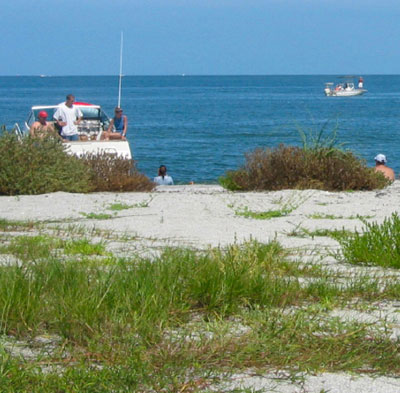
Boating off a beach at Cayo Costa State Park
North of Captiva Island are a set of islands with no
bridges to the mainland, and no means of access other than by boat.
Closest to Captiva, North Captiva Island broke off from its parent
island during a hurricane in the 1920s. Private and vacation rental
homes, a grassy airstrip, and a club occupy the quiet, 5-mile- (8-km-)
long island, along with superb beaches and restaurants. Walk or rent a
golf cart to get around the island.
Farther north, Cayo Costa Island is mostly occupied by
the Cayo Costa State Park, where visitors can
swim, collect shells, hike, and camp or rent cabins. Look out for the
pioneer cemetery along one of several nature trails.
Between Cayo Costa and the mainland, Cabbage Key has no
beaches, but its rustic 1920s Cabbage Key Inn is a great attraction for
the island-hopping lunch crowd. Have a bite to eat, and then walk it off
along a short nature trail. Visitors can also spend the night at the
inn, or in one of its cottages.
< The Lower Gulf Coast,
Everglades, and Keys
4. J. N. “Ding” Darling National Wildlife Refuge
Into the wild
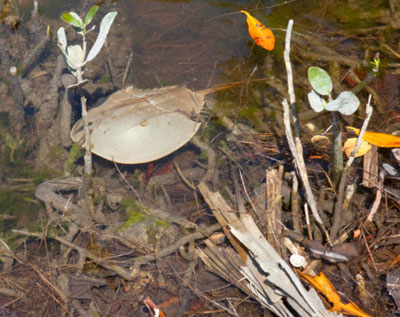
Horseshoe crab in J.N. “Ding” Darling National
Wildlife Refuge, Sanibel Island
Named for Jay Norwood, a Pulitzer-Prize-winning
American cartoonist, and covering more than half of Sanibel Island,
“Ding” gives the island its reputation among wildlife-lovers, especially
birders. It counts about 230 species of birds among its resident and
migrating populations, including the bald eagle, the roseate spoonbill,
and the mangrove cuckoo.
At its main campus along Sanibel-Captiva Road, the
refuge has an Education Center, a 4-mile (6-km) Wildlife Drive through
wetlands, an observation tower, and several trails. Nearby, Bailey Tract
protects a different freshwater habitat, which alligators and nocturnal
bobcats frequent.
Kids’ Corner
Bird’s eye view
At J. N. “Ding” Darling National Wildlife
Refuge, climb the observation tower on Wildlife Drive. Peek
through the telescope and see how many different types of
birds you can spot. Look closely for markings, and beak,
leg, and feet colourings.
Did you know…
Pileated woodpeckers drum on
trees with their beaks to establish their
territory and to attract mates.
Eastern screech owls come in
red, brown, or gray colors.
The two main reasons why bald
eagles are brought to CROW are electrocution and
fights with other eagles.
The magnificent frigate bird
is also known as a man o’ war.
< The Lower Gulf Coast,
Everglades, and Keys
5. Corkscrew Swamp Sanctuary
A big bird’s nest and age-old trees
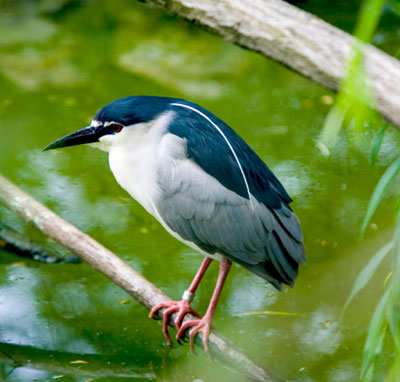
Black-crowned night heron in the Corkscrew Swamp
Sanctuary
Some 20 miles (32 km) inland lies a whole different
brand of water wonderland – the swamp. The Corkscrew Swamp Sanctuary is
the regional headquarters of the Great Florida Birding Trail, and here
nature-lovers can wander a 2-mile (4-km) boardwalk to explore a rich
habitat where alligators, bobcats, black bears, and white-tailed deer
cavort. Perhaps the sanctuary’s most important creature, however, is the
wood stork. These big white-and-black birds come to nest in the
500-year-old bald cypress trees. The towering trees, with their
protruding “knees,” constitute the species’ largest old-growth stand in
the country. The wood stork is only one of the 200 or so species that
visit the sanctuary – others include wading birds, songbirds, raptors,
the tricolored heron, and the fabulous painted bunting.
Kids’ Corner
Do you know…
What is the name of the margin
where seagrasses, shells, and other flotsam are
washed up at high tide?
Florida’s signature food fish
is sweet and mild and goes by a “gang” name. Can
you guess its name?
Fresh and salt water mix to
support a blend of sea life in a specific type of
habitat. Do you know what this habitat is called?
Crazy creatures
South Florida has some funny-looking
animals – pink birds that eat with spoons, potato-shaped
manatees, and toothy gators, crocodiles, and sharks. See
what really bizarre creatures you can come up with by mixing
different parts of the animals in your drawings – a manatee
with a roseate spoonbill’s legs and beak, for instance. What
names would you give your invented critters?
< The Lower Gulf Coast,
Everglades, and Keys
6. Naples
A little Italy, Florida-style
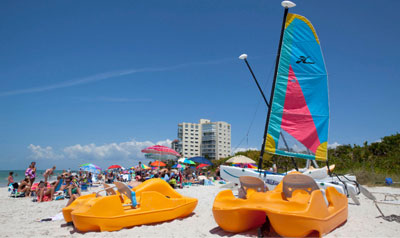
Vanderbilt Beach, a popular white-sand beach in
Naples
The hardy pioneers who settled south of Florida’s west
coast compared the area’s beaches and waterways to those of Italy, and
so they named their settlement Naples-on-the-Gulf. Today, the city’s
architecture and cuisine have an Italian flavor.
Once a rough-and-tumble Indian trading post, Naples has
evolved into a haven for vacationers seeking golf, shopping, and fine
dining. The heart of downtown, known as Old Naples, has two fashionable
streets – Fifth Avenue South and Third Street South. Most of the town’s
superb restaurants are located here. Near Third Street South, the Naples
Pier stretches into the Gulf of Mexico from the beach’s soft white
sands.
Northeast of the downtown area, the Children’s Museum of Naples is located in
North Collier Regional Park, also home to the Sun-n-Fun Lagoon water park. In the museum, kids can drive a
facsimile of the Naples Trolley, climb up to a tree house, walk into a
seashell, and chill out in an igloo.
With the Everglades at its back door, Naples sees plenty
of wildlife. However, the easiest way to spot animals – local and from
as far away as Madagascar – is to head to Naples
Zoo. Special animal shows, giraffe hand-feeding, and a boat
excursion to Primate Island add adventure to a visit.
Kids’ Corner
Turtle tutorial
Sea turtles make nests on Florida’s
beaches from April to October. At night the females dig
holes in which to lay their eggs, which look like Ping-Pong
balls. Each turtle lays about 100 eggs, and the heat of the
sand determines whether each egg hatches as a boy or a girl.
An adult leatherback turtle can weigh up to 907 kg (2,000
lb). Sea turtles can live to be 150 years old!
< The Lower Gulf Coast,
Everglades, and Keys
7. Marco Island
Indians, fishermen, and one cool cat
The jumping-off point for Ten Thousand Islands, a maze
of protected islands to the south, Marco Island prides itself on its
fishing and boating. Rent or charter a boat from one of the island’s
marinas and get out on the water. At its east end, the fishing town of
Goodland retains the salty character of old-time fishing communities.
The Calusa Indians fished these waters for 1,500 years,
until they were wiped out by European invaders. They built one center of
their kingdom on Marco Island, as revealed by archaeological excavations
in 1895. One important find, a carved wood effigy known as the Key Marco
Cat, now resides in the Smithsonian Institution in Washington D.C.
Families can drive over the top of one 58-ft (18-m) ancient shell mound
and follow trails along another at the Otter
Mound Preserve.
Two public beach accesses welcome visitors to Marco’s
wide beaches. Tigertail Beach has playgrounds
and a sheltered lagoon that draws lots of birds, especially in winter.
< The Lower Gulf Coast,
Everglades, and Keys
8. Everglades National Park
Florida’s land down under
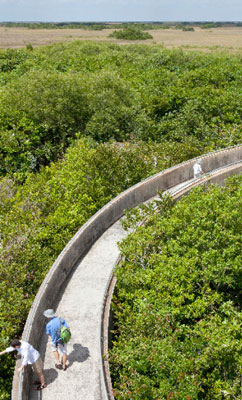
View from the observation tower
Displaced Native Americans and outlaws were among
the first to settle in this forbidding land riddled with swamps at
the very bottom of Florida. Later came slick developers who wanted
to drain the precious wetland in favor of building. Luckily, Marjory
Douglas Stoneman stepped up in the 1940s to make sure that this
special territory would forever be protected as the Everglades
National Park. Today, the park safeguards 2,200 sq miles (3,540 sq
km), and more than 1,000 species of fish, birds, reptiles,
amphibians, and mammals.
Key Sights
1. Flamingo Visitor Center See the
exhibits and pick up maps for exploring trails and waterways.
Besides a marina and store, the center also has a campground on
Florida Bay.
2. Trails along the drive to Flamingo
The 38-mile (60-km) Main Park Road passes four major trailheads
for short hikes: Pinelands Trail, Pa-hay-okee Overlook, Mahogany
Hammock Trail, and West Lake.
3. Long Pine Key Arguably the
prettiest spot in the Everglades, this area’s forest of pine
trees is perfect for picnicking, or an overnight stay in the
well-kept campground.
4. Royal Palm Visitor Center The first
stop along the Main Park Road to Flamingo, this is one of the
best places to spot wildlife. The popular Anhinga and Gumbo
Limbo trails begin here.
5. Ernest Coe Visitor Center/Main
Entrance This center lies outside the park gates and its
interactive exhibits make a good introduction to the park.
6. Shark Valley Entrance/Visitor
Center Hike, bike, or take the tram tour from here
around the 15-mile (24-km) loop trail. Climb the observation
tower for fine views.
7. Gulf Coast Entrance/Visitor Center
Hiking, boating, kayaking, and biking tours depart from this
west coast gateway in the historic fishing town of Everglades
City.

Left Ernest Coe Visitor Center
Middle Flamingo Visitor Center
Right Royal Palm Visitor Center
Kids’ Corner
Croc or gator?
How can you tell a crocodile from an
alligator? Luckily, you don’t have to get too close to
distinguish one from the other!
The American alligator has
dark skin and a wide snout for cracking turtle
shells.
A croc is lighter in color
than a gator, with a narrower, pointier snout and
a flatter profile in the water.
When a gator closes its
mouth, the teeth in its top jaw are the only ones
visible. When a croc closes its mouth, you can see
its distinctive overbite: the teeth of both jaws
are visible.
How Do You Spell “Everglades”?
Write out Everglades National Park,
leaving spaces between the letters. For each letter in the
park’s name, think of something you saw or learned about
that starts with that letter. Write them down, until you’ve
used up all 22 letters with no repeated words.
Collecting birds
Serious birders keep what they call a life
list – a record of every species of bird they have seen in
the wilds during their lifetime. The Everglades, with 366
species, is the best place to start your Florida life list.
< The Lower Gulf Coast,
Everglades, and Keys
9. Biscayne National Park
Water, water, everywhere
This vast, mostly underwater refuge encompasses the
third-longest stretch of coral reef in the world. Geographically, the
park kicks off the Florida Keys, and, for outdoor enthusiasts, it has it
all – boating, kayaking, snorkeling, scuba diving, hiking, camping, and
also a slice of history dating back to the Tequesta Indians. However, it
takes some effort to enjoy what’s best about the park, namely what’s
under and out on the water. Biscayne’s two main islands – Boca Chita and
Elliott Key – are accessible only by boat, but worth the trip to learn
about some quirky elements of local history, hike trails, go fishing,
and camp overnight.
Kids’ Corner
Plant a tree
When paddling among the saltwater
mangroves, look out for long, green, bean-like seeds bobbing
in the water. Known as props (short for propagules), they
drop off of mangrove trees. If you find one, stick the
sprouting end into mud to give life to another tree.
< The Lower Gulf Coast,
Everglades, and Keys
10. Miccosukee Indian Village
Going native
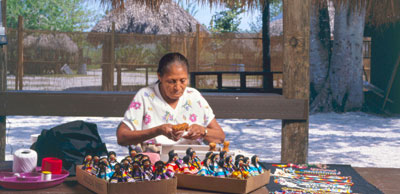
Palmetto dolls and beadwork for sale in the
Miccosukee Indian Village
The Miccosukee Indian tribe has lived at the edge of
the Everglades on a narrow strip of land since the Seminole Wars chased
them from their homeland, Tallahassee, in the 1800s. Today, visitors can
experience their way of life and learn about their beliefs at this
village. Guided and self-guided tours of the superb museum and its
grounds explore the history of the Miccosukee and their thatched huts,
or chickee, with elevated floors. Members of the tribe give
daring alligator presentations and demonstrate native crafts all day.
< The Lower Gulf Coast,
Everglades, and Keys
11. Big Cypress National Preserve
Bald cypresses, furry critters, and feathered
friends
The US government legislated the creation of Big
Cypress to put an end to logging operations that were depleting the
forest of its tall, beautiful, bald cypress trees. The preserve provides
a number of options for adventure enthusiasts. Begin at the Oasis Visitor Center or Big Cypress Swamp Welcome Center. The Oasis’
boardwalk is a great place to see gators swimming down below. Walk the
boardwalk at the Big Cypress and listen to the manatees blow as they
surface for a breath of air. Pick up a map at either center and rent a
kayak in Everglades City to paddle trails, or hike on part of the
statewide Florida Trail. In the dry season, following one of the scenic
drives is a good idea.
< The Lower Gulf Coast,
Everglades, and Keys
12. Everglades City
Gateway to the Gulf Coast
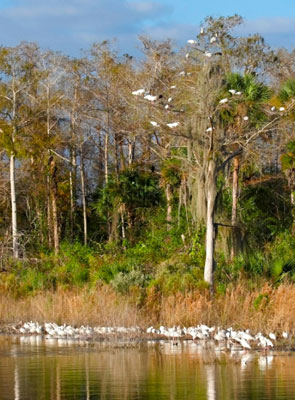
Bald cypress trees in Fakahatchee Strand State
Preserve
Located at the western entrance to the Everglades
National Park, this sleepy little town offers opportunities for fishing,
kayaking, and airboat rides. Nearby, there are attractions that
introduce families to the Everglades’ unique plant and animal life. The
Fakahatchee Strand State Preserve, 5
miles (8 km) north of town, is known for its wild orchids. Located 15
miles (24 km) to the northwest, the
Collier-Seminole State Park is the place for biking, hiking,
and camping. From here, head for
Wooten’s Airboat
Tours (
www.wootenseverglades.com), 6 miles (9 km) to the northeast,
where a gator pond and animal exhibits, as well as shows, supplement
tours.
Kids’ Corner
’Glades vocab
’Glades: Long before
Everglades National Park existed, the name
Everglades was applied to the region and its
ecology. “Ever” comes from the word “forever” and
“glades” means a forest clearing. Locals call it
’Glades for short.
Seminoles: The US government
gave this name, which means “runaway,” to the
almost 20 different tribes that migrated to
Florida in its early days before statehood.
Airboat: Specially made for
Everglades travel by frog hunters, this noisy,
jet-propelled craft practically flies across the
local shallows.
Swamp buggy: Engineered
specifically for traveling across Everglades
wetlands, its big tires and elevated bed make for
high-and-dry touring.
Sharp spotter
On the drive across the Tamiami Trail, you
will see lots of alligators alongside the parallel-running
waterway. A little tricky to spot, they may be on the bank
sunning themselves, or in the water. Take a close look at
what appears to be a log. If you can see a snout and what
looks like tire tread, you’ve got yourself a gator!
< The Lower Gulf Coast,
Everglades, and Keys
13. Key West
Pirates, shipwrecks, and treasure
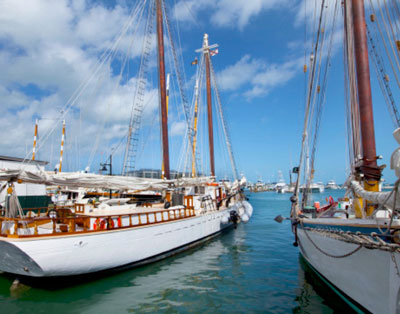
Historic Seaport at Key West Bight
Ever seen a six-toed cat or a man riding a bike
with an iguana on his shoulder? Both sights are likely in Key West,
the most popular destination in the Florida Keys. The Old Town, the
city’s downtown core, is known for its party vibe. Nonetheless, a
wealth of attractions and a history dating back to 19th-century
pirates makes it a huge draw for families. It lies at the end of a
necklace of keys (small islands) where wildlife encounters, beaches,
parks, and watersports fill mellow days.
Key Sights
1. Historic Seaport at Key West Bight
This restored neighborhood and its Harborwalk form the earthy
heart of Old Town, filled with activity, shopping, dining, and
watersports charters.
2. Mallory Square Celebrate sunset
every night at this cruise ship dock, with musicians and
magicians, and conch fritter and margarita vendors.
3. Key West Aquarium Built in 1934,
this was the world’s first open-air aquarium, though it is now
mostly enclosed. Take a tour to watch the guides feed sharks,
stingrays, and sea turtles.
4. Eco-Discovery Center This
attraction shows off the Keys’ natural treasures – their
valuable coral reef and ecosystems. Kids will like the
walk-through model of an underwater ocean lab.
5. Fort Zachary Taylor Historic State
Park This Civil War-era fort sits on prime beachfront.
Follow a fort tour with a dip and a nature hike.
6. Key West Lighthouse Museum Climb
the 88 steps to the top of the 92-ft (28-m) tower built here in
1844, for fine views. Go to the adjacent lighthouse-keeper’s
home, where historic exhibits tell the story of the keepers.
7. Ernest Hemingway Home and Museum
Find about 50 six-toed cats snoozing around this house, where
famous novelist Ernest Hemingway lived and wrote from 1931 to
1942.
8. Key West Butterfly and Nature
Conservatory Walk into a glass bubble that encases more
than 40 species of butterflies, plus birds, waterfalls, and lush
vegetation. The gift shop is also a must-visit.

Left Key West Lighthouse Museum
Middle Fort Zachary Taylor Historic State
Park Right Entrance to Mallory Square
Kids’ Corner
Turtle tale
Five different types of endangered sea
turtle inhabit the waters of the Florida Keys. What are they
called?
Critter menu
While learning about the Keys’ wildlife –
its fish, dolphins, sharks, turtles, manatees, birds,
butterflies, and deer – pay close attention to the kinds of
food each animal likes to eat. Using paper and crayons,
write and illustrate a dinner menu for all the animals you
have encountered.
Write on!
Besides Hemingway, Key West has inspired
Robert Frost, Tennessee Williams, and other great writers.
See if you can become the next great Key West author by
writing a short story using the prompt, “The first day I
visited Key West, I could not believe…”
Tricky … and sneaky
Did you know that wreckers once made Key
West the richest city in the world? The wreckers would
deliberately cause shipwrecks by hanging lanterns near
dangerous coral reefs. As ships crashed onto the reefs, the
wreckers would row out to rescue passengers and crew, but
they also grabbed any valuable cargo the ships were
carrying.
< The Lower Gulf Coast,
Everglades, and Keys
14. Big Pine Key
Home of the Key deer
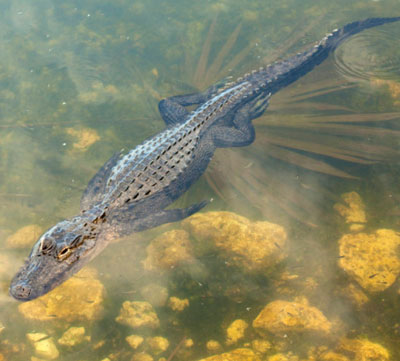
An alligator in the Blue Hole, a flooded limestone
quarry in Big Pine Key
Just over the bridge from downtown Key West, there is
a distinct change of pace as the Overseas Highway takes visitors to a
slower, more relaxed part of Florida.
Look out for Mile Markers, the small green rectangular
signs that mark the miles and give directions in the Keys. Around about
MM 32, signs caution drivers to slow down to protect the endangered Key
deer population of Big Pine Key. The best place to spot these undersized
deer, fewer than 800 of which remain, is the National Key Deer Refuge at No Name Key. While in the refuge,
visit the Blue Hole, an old quarry filled with water that is home to one
resident alligator, as well as other wildlife, and then hike the easy
trails.
Big Pine Key is also known for fishing and kayaking.
Paddling trails lead into refuge waters that look like a maze of
mangrove islands. Follow a tour to avoid getting lost.
Kids’ Corner
Did you know…
The Key deer is a subspecies
of the Virginia white-tailed deer.
The male Key deer is less than
32 inches (81 cm) high at the shoulder and weighs
around 36 kg (80 lb).
By 1927, hunters had decimated
Key deer numbers to fewer than 30.
Key deer are mostly found in
Big Pine Key, but they range around the Lower Keys
and even swim to some islands not connected by
roads.
< The Lower Gulf Coast,
Everglades, and Keys
15. Bahia Honda State Park
Great beaches and a really long bridge
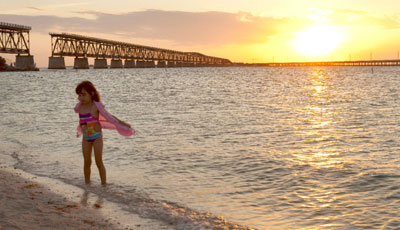
Old Bahia Honda Bridge, seen at sunset from Bahia
Honda State Park
Often seen on America’s best beaches lists, Bahia
Honda’s white sands, turquoise waters, multihued coral reefs, and
well-stocked marina make it great for families. Swimming and snorkeling
are the most popular activities, but the marina also rents kayaks. It is
possible to explore the offshore reef on a snorkeling cruise that the
marina offers twice a day. Rangers lead hikes and host talks year-round;
consider hiking the beautiful Silver Palm Nature Trail.
At the end of Bahia Honda Key, at MM 40, the Overseas
Highway reaches one of the world’s longest segmental bridges – the famed
Seven-Mile Bridge. This railroad bridge is now disused but was
considered an engineering marvel when it was completed in 1912 and is
listed on the National Register of Historic Places. It is possible to
walk or bike along the old bridge, and fish from the northernmost 2-mile
(3-km) section, which is accessible from Marathon.
Kids’ Corner
Snorkel scavenge
To preserve reefs, you should avoid
touching the coral and collecting shells or other sea life.
But after you’ve surfaced, see who can tally up the most
points for having spotted these reef and seagrass meadow
inhabitants:
- Tubed Sponge (1 point)
- Sergeant Major Fish (1 point)
- Conch Shell (1 point)
- Angelfish (1 point)
- Sea Fan (1 point)
- Fire Coral (2 points)
- Sea Urchin (2 points)
- Sea Cucumber (3 points)
- Spiny Lobster (4 points)
- Sea Turtle (5 points)
- Octopus (5 points)
- Sea horse (5 points)
< The Lower Gulf Coast,
Everglades, and Keys
16. Marathon
Dolphins and pirates
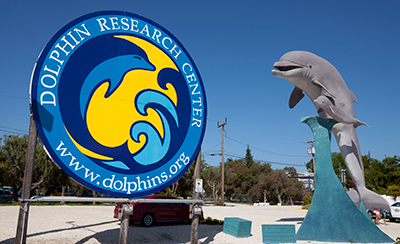
The Dolphin Research Center, Grassy Key, home to
both dolphins and sea lions
Outside of Key West, the town of Marathon holds most
of the Keys’ historic and natural attractions. The neighboring Grassy
and Duck keys boast two dolphin encounter operations – the Dolphin Research Center and Dolphin Connection – where visitors can pet
a dolphin and also paint with one.
Another type of Keys sea life can be seen on the mend at
the Turtle Hospital. In summer, the
possibility of seeing sea turtle hatchlings adds more excitement to
visiting and feeding the mammoth adults.
Crane Point combines nature
and history in extensive waterfront woods. There is a natural history
museum, a pirate dress-up ship for kids, the Wild Bird Center, a
historic home, and nature trails.
Marathon was named for the breakneck speed at which the
railroad was built. Below the Seven-Mile Bridge, Pigeon Key was home to the construction workers. Board a ferry
(305 743 5999) at Marathon’s southern end to tour the old
village and its railroad museum.
Kids’ Corner
Turn over a new leaf
Crane Point’s Hammock Loop Trail
identifies the types of trees you will see throughout the
site. Carry a notepad and pencil to make a sketch of each
tree and its leaves, to help you spot them along the way.
< The Lower Gulf Coast,
Everglades, and Keys
17. Islamorada
Fighting fish, hungry tarpon, and the tree of
life
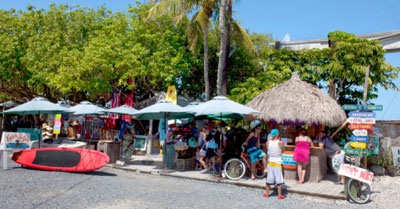
Kayak Shack at Robbie’s Marina selling a variety of
merchandise, Islamorada
Known as the sport-fishing capital of the world,
Islamorada is a 20-mile (32-km) strip of seven separate islands. A good
place to start exploring Islamorada’s rich sea world is Robbie’s Marina, located at the southern end
of the chain of keys. Buy a bucket of bait to feed the powerful tarpon
at the dock, shop the crafts booths, and sign up for a boat ride to Indian Key State Park and Lignumvitae Key Botanical State Park.
Alternatively, rent a kayak from Robbie’s Marina and paddle out to
Indian Key State Park. Be sure to bring along snorkeling equipment.
Visit the History of Diving
Museum to discover more about underwater exploration. The museum
has exhibits on sunken treasure, the filming of 20,000 Leagues Under
the Sea, and early diving gear. Children will enjoy the Theater of the Sea, where they can interact
with dolphins, sea lions, and stingrays, or ride a glass-bottom boat to
see what lies under water.
Kids’ Corner
Do you know…
Why the early settlers named
Islamorada “the purple island”?
Fishy riddles
From the clues below, guess the names of
these fish that swim in Keys waters:
I’ve got something to pick
with this fish.
It’s not a Smurf, but
maybe it’s related.
When I see this fish, I
think I’ve died and gone to heaven.
I wonder if this fish
would like a cracker.
< The Lower Gulf Coast,
Everglades, and Keys
18. Key Largo
Underwater capital of the world
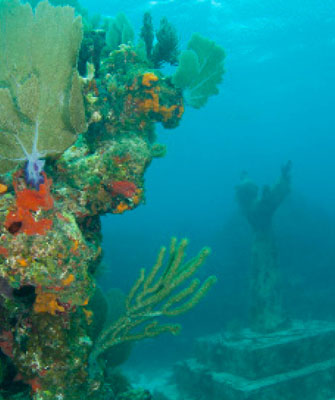
Colorful corals in Key Largo, with the Christ of
the Deep in the background
One of the most popular destinations for snorkeling in
the world, Key Largo is famous for its namesake movie
Key Largo
(1948) starring Humphrey Bogart , although no actual filming took place
here. Today you can see the original steamboat that starred in
The
African Queen (1952) at the marina, next to the Holiday Inn at
MM 100 – it does cruise tours. There is also a glass-bottom boat here,
the
Key Largo Princess (
www.keylargoprincess.com), which offers tours of the
region’s legendary coral reefs.
Created in 1990, the Florida Keys
National Marine Sanctuary protects 2,900 sq nautical miles
(9,947 sq km) of waters surrounding the Florida Keys and more than 6,000
marine species. Just step into the water to reach the sanctuary, or
explore the colorful world of coral and fish by snorkeling or scuba
diving. Charters also take visitors under water to see the submerged
9-ft (3-m) statue, Christ of the Deep. Alternatively, the dolphin
encounter operations in Key Largo, Dolphins
Plus, offers educational and interactive programs, as well as
sea lion swims.
Kids’ Corner
Do you know…
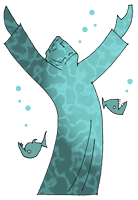
1. That Lignumvitae Key shares its
name with a rare tree that grows here. What does
Lignumvitae mean in Latin?
2. If it is true that the original
casting of the Christ of the Deep is submerged in
the Mediterranean Sea?
The Long Island
Key Largo is one of several keys in the
chain that were named by Spanish explorers. In Spanish, it
means “long key,” and true to its name, it is 15 miles (24
km) in length.
< The Lower Gulf Coast,
Everglades, and Keys
19. John Pennekamp Coral Reef State Park
Nature meets history
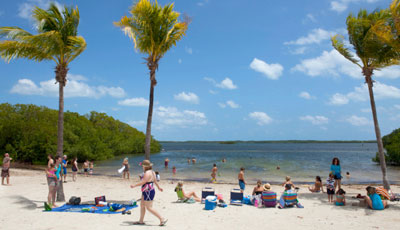
Far Beach, a scenic strip of sand in John Pennekamp
Coral Reef State Park
The first undersea park in the US, the John Pennekamp
Coral Reef State Park is located close to the Florida Keys National
Marine Sanctuary. The visitor center has a massive reef aquarium, and
the park’s concessions provide diving, snorkeling, and glass-bottom boat
excursions, and rent out equipment. Snorkelers off Cannon Beach can see
the ruins of a Spanish ship just 100 ft (30 m) from shore. Families can
rent kayaks, canoes, and powerboats, or hike the short trails and then
picnic at one of the two beaches in the park. Pretty, palm-fringed Far
Beach is ideal for a relaxing day spent sunbathing or splashing around
in the water.
Kids’ Corner
Colorful coral
Corals have transparent bodies. They get
their brilliant colors from algae, called zooxanthellae,
that live in their tissues.
